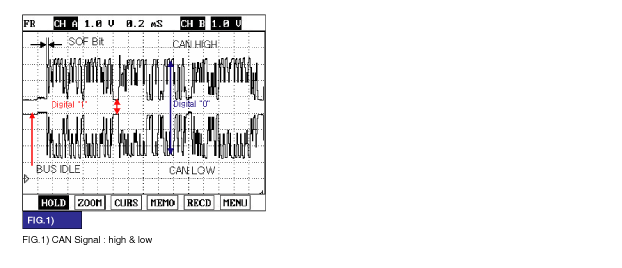Shift to N Range.
Specification : Signal Waveform & Data

The above value is only for reference.
The actual value may differ from it according to various engine condition.

CAN communication is a parallel circuit to interchange information among each units. CAN communication can share much information with units more faster and more efficiently by using specified language.
CAN-High line is twisted with CAN-Low line as a purpose in preventing from a noise.
The operating duty of EMC is maintained at 100 : 0 (2WD) for guaranteeing stabilized driving force, accuracy of the control during inside ABS, FTCS, ESP control.

This code related to communication line between ECU(PCU, ABS, ESP) and TCCU is set when CAN signal from ECU can't received for more than 1sec or ECU internal error occur.
If failure is detected TCCU prohibits the ITM control and cuts the current to control coil.
Item | Detecting Condition | Possible Cause |
DTC Strategy | ● ABS-ITM Communication Line, or ECU side malfunction | ● CAN HIGH/LOW circuit open/short ● Faulty ABS/ESP ● Faulty TCCU |
Enable Conditions | ● Message present 1.0 sec self clearing | |
Threshold Value | ● Loss of the 4D0H message for greater than 1 second | |
Diagnostic Time | ● 1 sec | |
MIL on condition | ● 0.5 Sec | |
Fail Safe | ● Fault code stored in memory, and ABS/ESP strategy deactivated |

Ignition ON, Engine : ON.
TCCU connector : Connect.
Monitor signal waveform between terminal 4, 5 of TCCU harness connector and chassis ground.
Shift to N Range.
Specification : Signal Waveform & Data

The above value is only for reference.
The actual value may differ from it according to various engine condition.
Is CAN Signal display near the specified value?

▶ Fault is intermittent caused by poor contact in the sensor's and/or TCCU's connector or was repaired and TCCU memory was not cleared.Thoroughly check connectors for looseness, poor connection, bending, corrosion, contamination, deterioration, or damage. Repair or replace as necessary and then go to "Verification of Vehicle Repair" procedure.

▶ Go to " CAN comm. Line Inspection " procedure.
Many malfunctions in the electrical system are caused by poor harness and terminals. Faults can also be caused by interference from other electrical systems, and mechanical or chemical damage.
Thoroughly check connectors for looseness, poor connection, bending, corrosion, contamination, deterioration,or damage.
Has a problem been found?

▶ Repair as necessary and go to "Verification of Vehicle Repair" procedure.

▶ Go to " CAN Signal Inspection " procedure.
IG "OFF" & ENG "OFF"
TCCU connector : Disconnect.
Measure resistance between terminal "4" of the TCCU harness connector and terminal "5" of the TCCU harness connector.
Specification : Approx. 60Ω

The above value is only for reference.
The actual value may differ from it according to various engine condition.
Is resistance display near the specified value?

▶ Fault is intermittent caused by open or short in CAN signal harnessor was repaired and TCCU memory was not cleared. Go to the applicable troubleshooting procedure.

▶ Check for open/short in CAN comunication line of TCCU circuit.
▶ Check for the signal or component of Engine control module.
▶ Repair as necessary and then go to "Verification of Vehicle Repair" procedure.
Connect scan tool and select "Diagnostic Trouble Codes(DTCs)" mode.
Using scantool, Clear DTC.
Operate the vehicle within DTC Enable conditions in General information.
Are any DTCs present ?

▶ Go to the applicable troubleshooting procedure.

▶ System is performing to specification at this time.